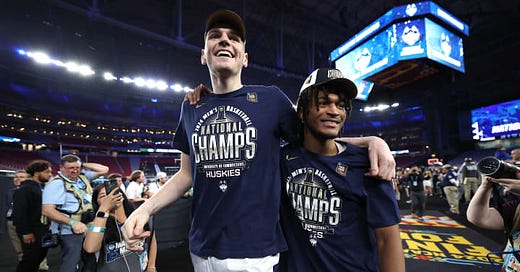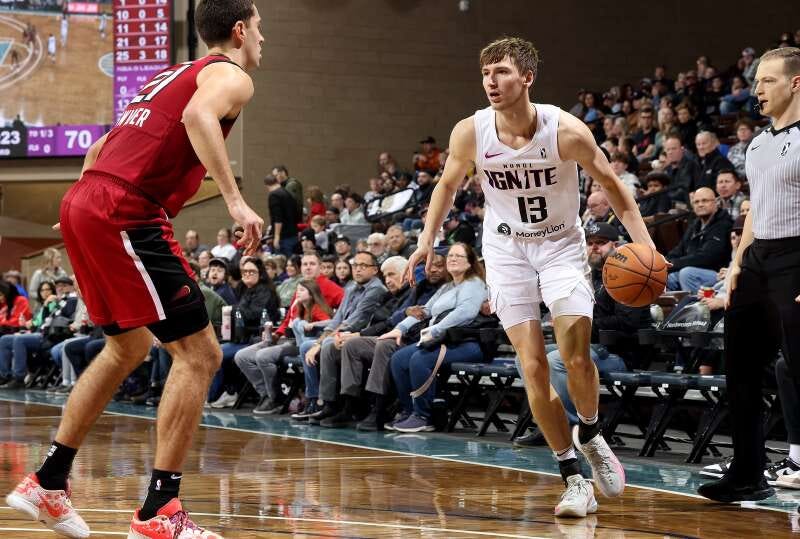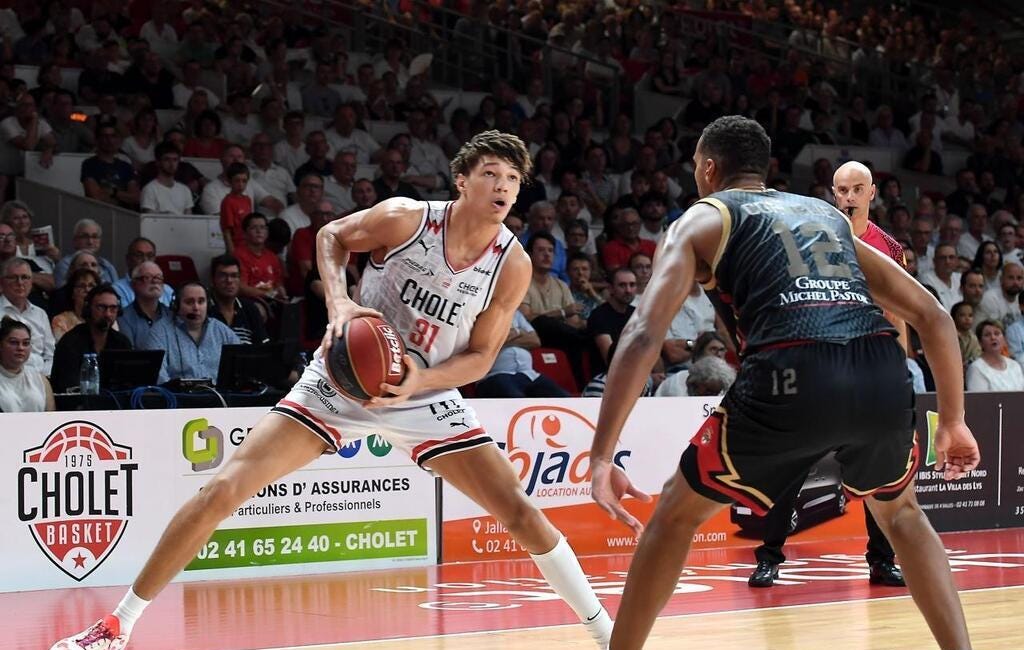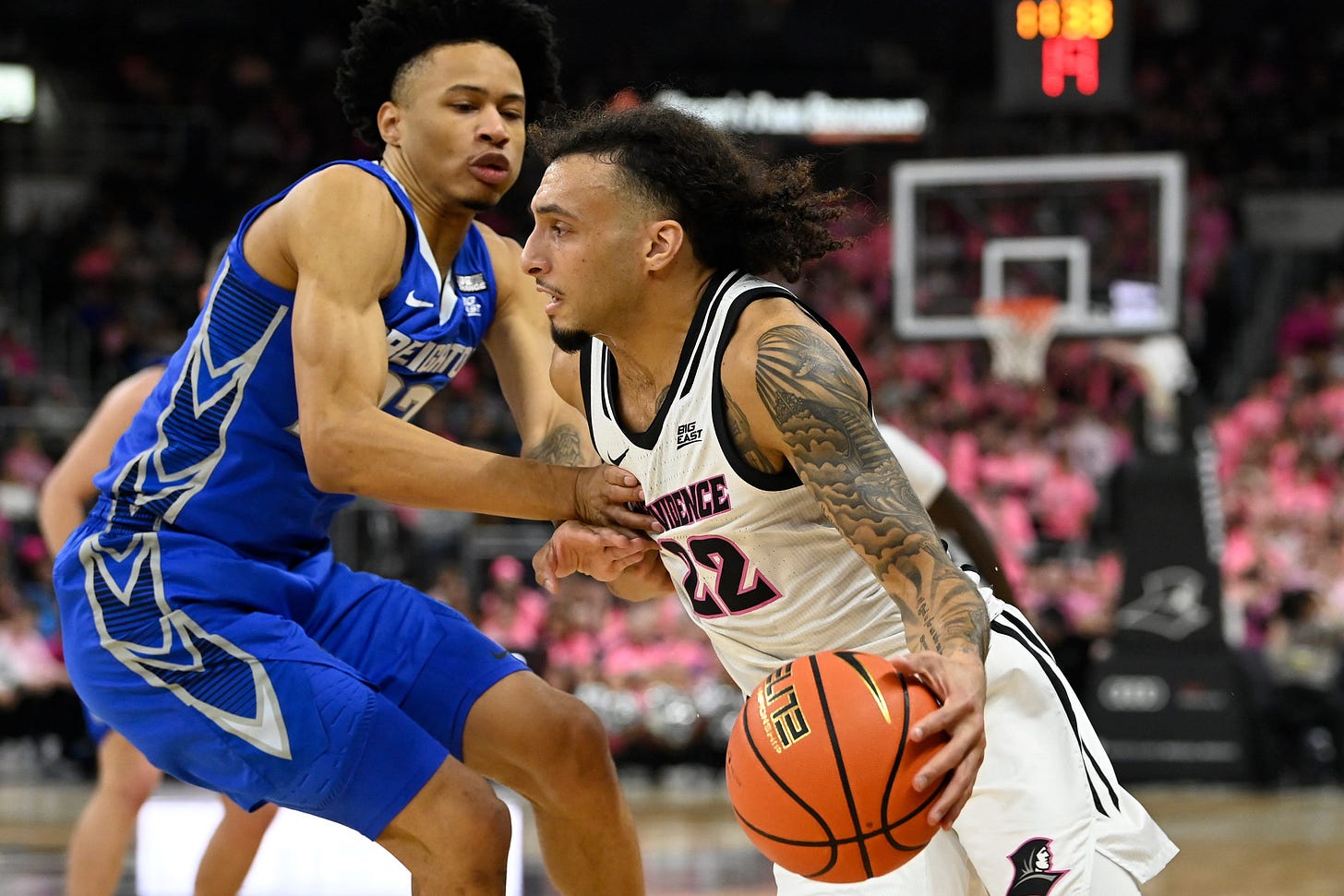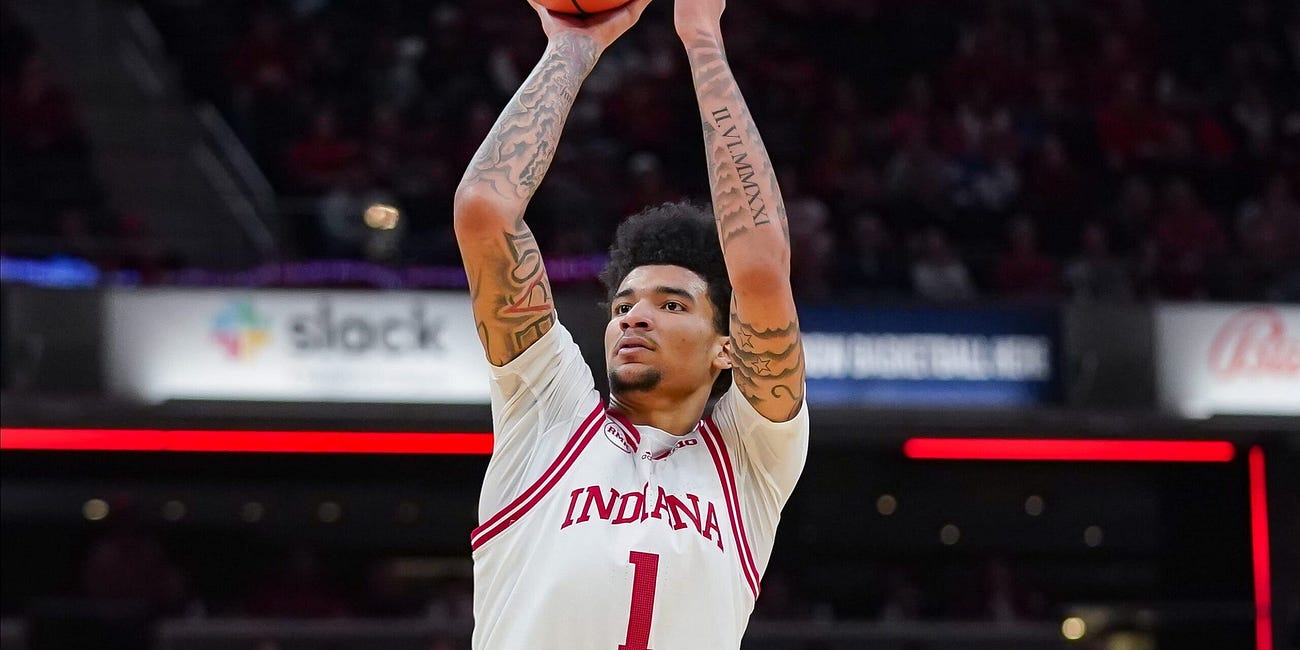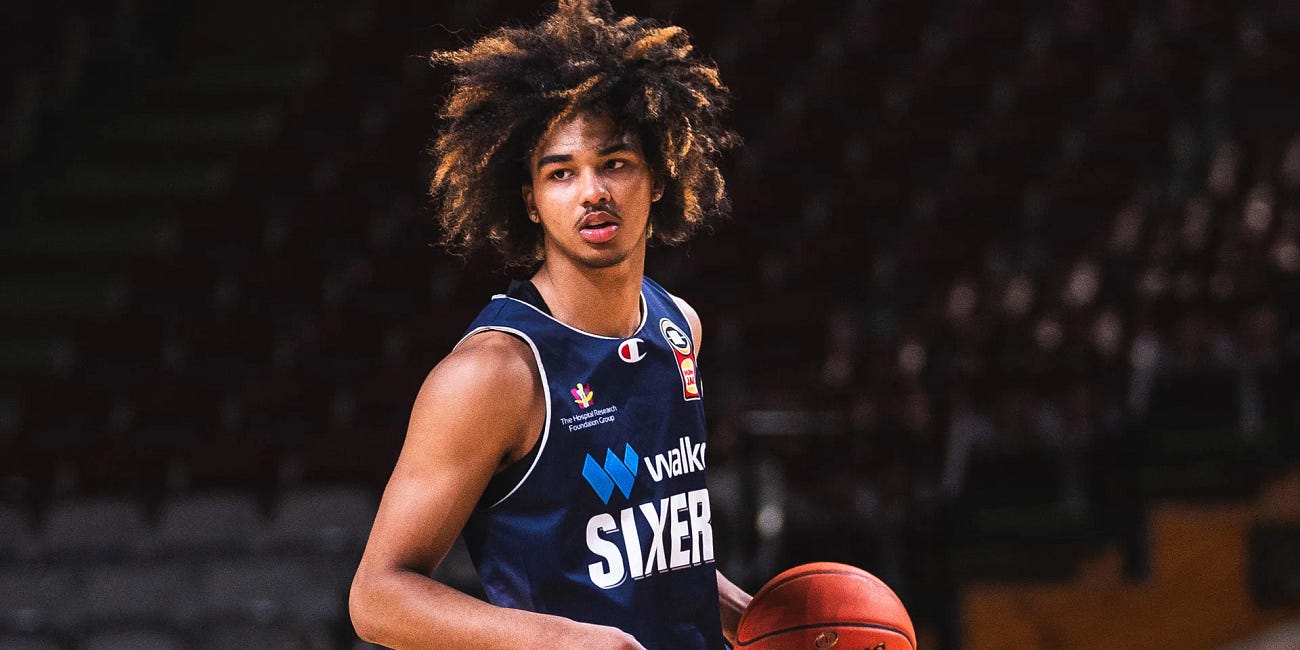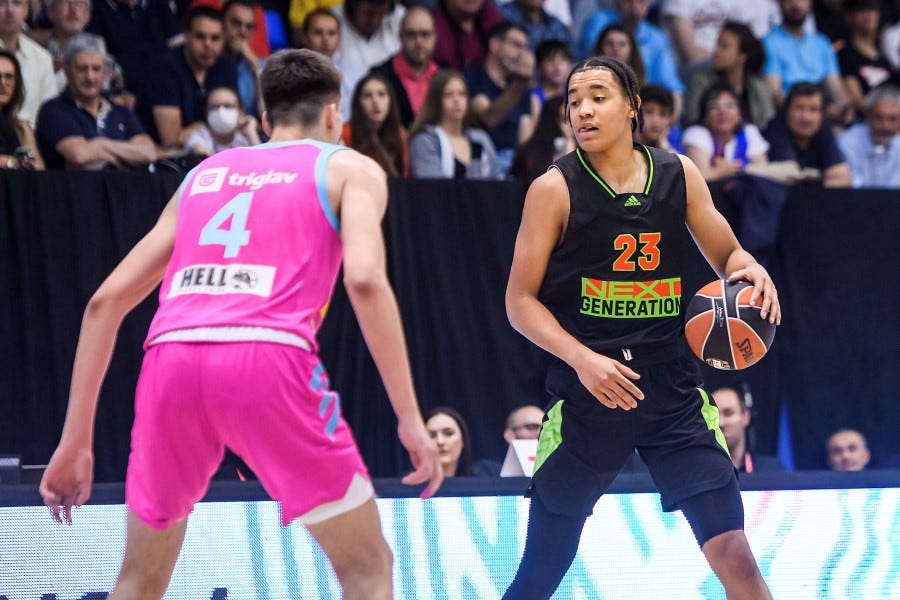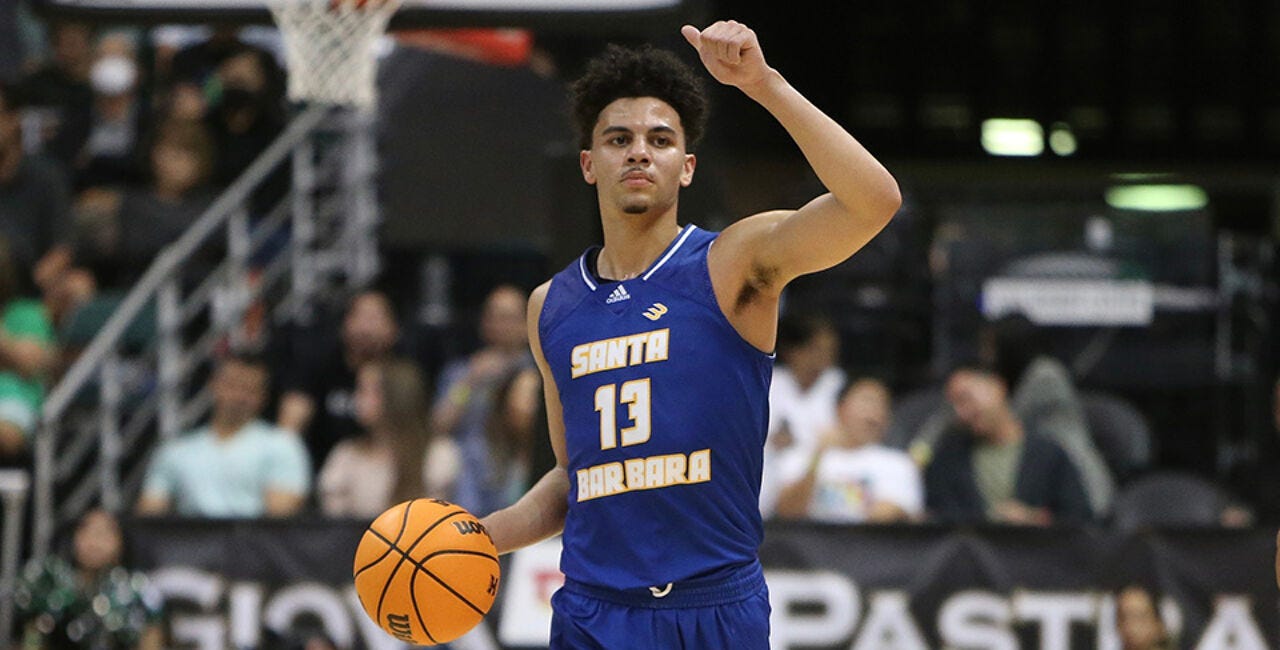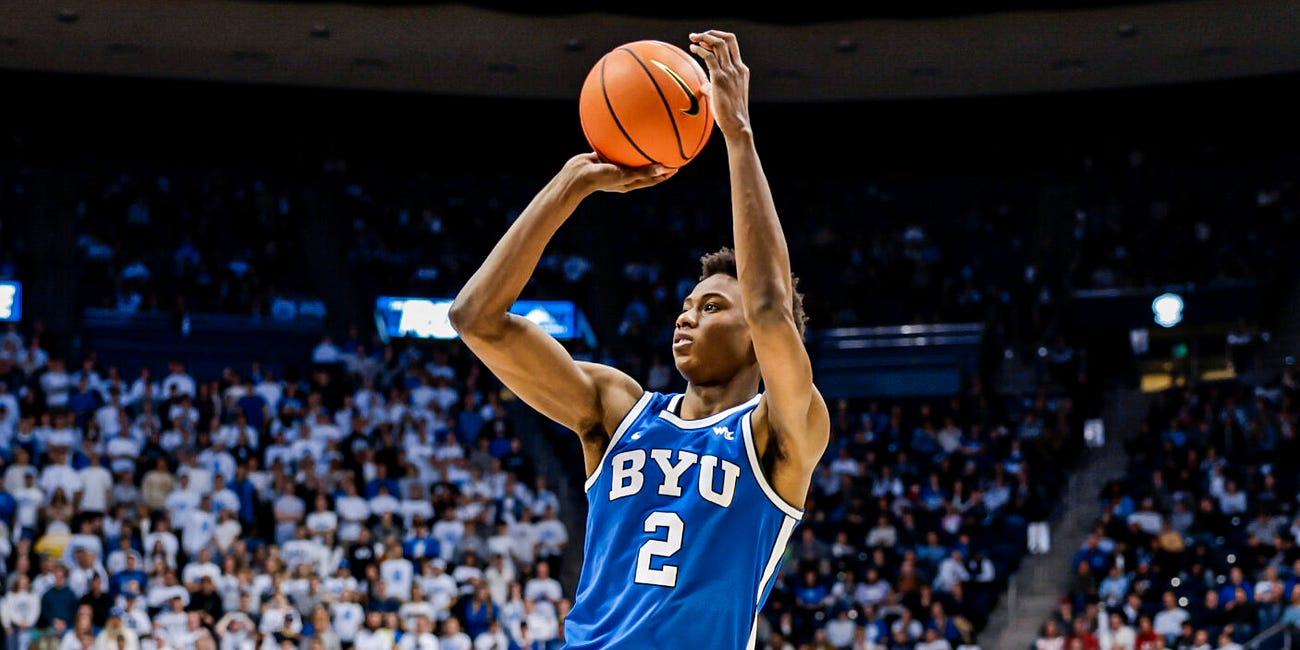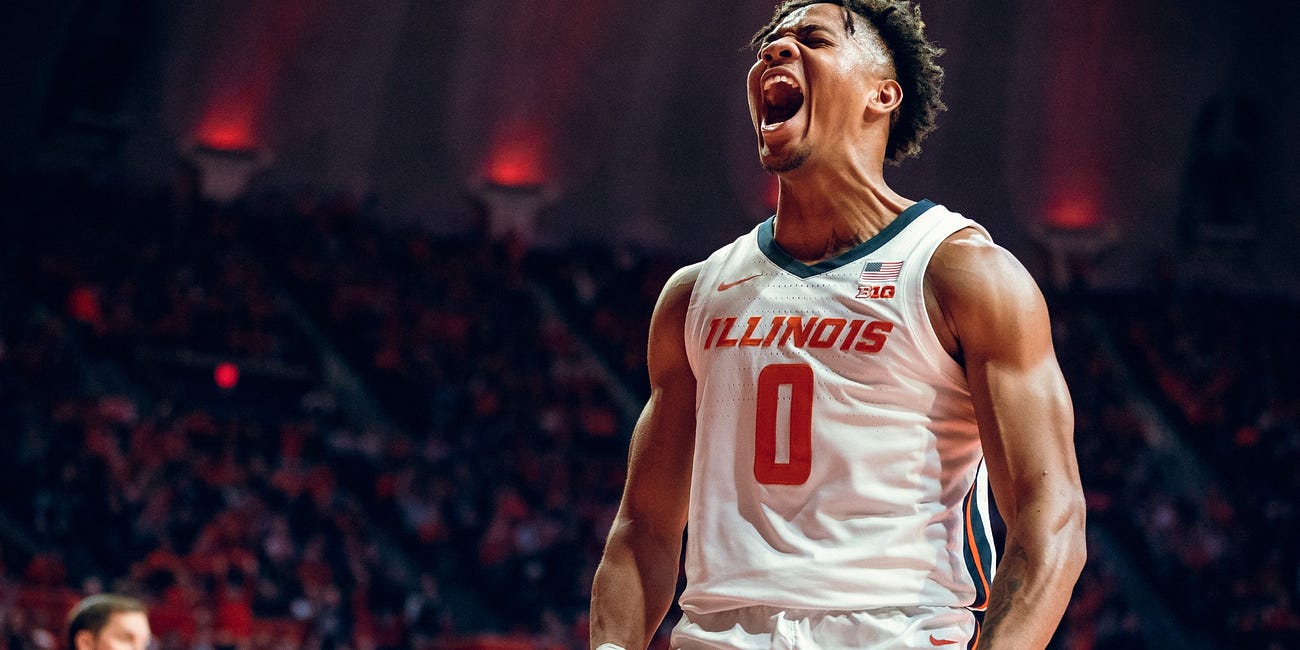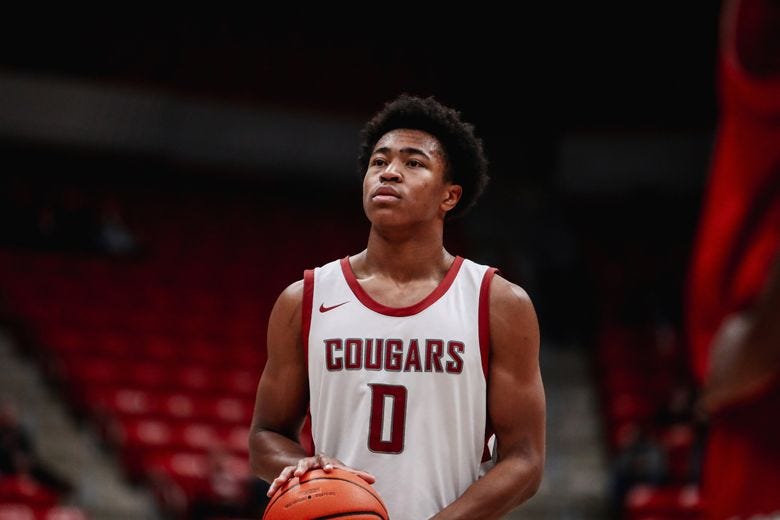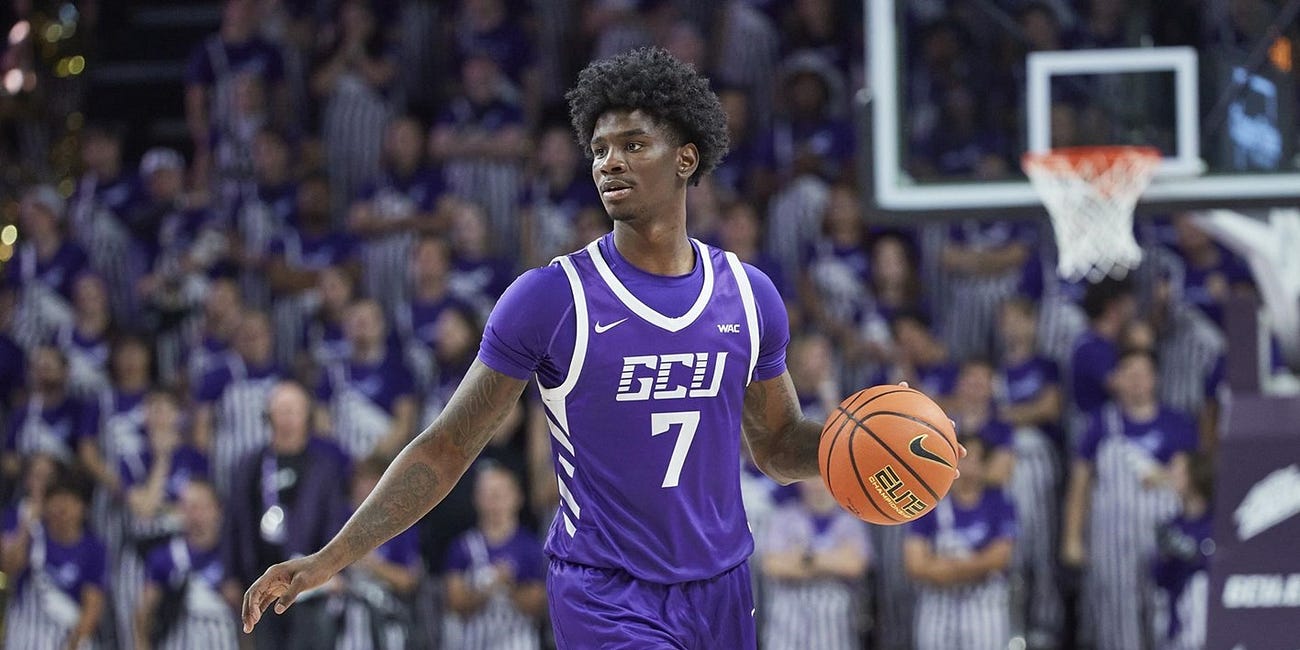2024 NBA Draft Big Board 3.0 — First Round
Here is my third big board of this year's draft cycle! All selections include an explanation in the form of a profile summary. Feel free to share so it can find a broader audience.
It’s here! My third big board of the season. The first two are available on X for reference at the end of the article. The article shows a graphic with my selections with explanations later on. For some players that includes a potential destination.
With over 45 in-depth scouting reports available on my Substack, it’s worth subscribing so you won’t miss out on future ones. Don’t worry I have you covered now as well. Embedded posts direct you to already-written reports on ranked players.
The Top 30
1. Ron Holland (2005) — G League Ignite
Ron’s combination of physical tools and explosiveness make him a team’s first option in the long run. There’s a lot to say about the lack of efficiency and careless turnovers in the early stages of his year in the G League.
However, the importance of the context of his playing position — a four in high school who transitions to a leading scorer as a wing is naturally going to take time. Adding onto that, Holland had to adjust to defenses that were crowding the paint with him being a developing three-point shooter. While being accustomed to shooting threes from 19-foot 9-inches, all of a sudden there were four feet added onto that, displaying the NBA three-point line.
Holland will need time to find a healthy balance between his drives to the rim, making plays for others as a ball handler, and serving as an off-ball option. His handles quickly improved in the G League. His three-point shooting is a work in progress that’ll carry over to the NBA, but his natural tools and ability to generate paint touches are what will be way more effective once he transitions to a league-average scorer.
In terms of potential, Holland is the most gifted prospect in this class. However, it may take him a few years to figure things out. With the ability to serve as a team’s first option, combined with his exceptional physical tools, Holland is the first overall pick on my board.
2. Donovan Clingan (SO.) — Connecticut
In a league where shooting has never been more important, Clingan is number two on my board, despite him being a non-shooter. That’s correct. The context behind this selection is that most teams already figured out who their scoring guards and wings will be. And that combined with a drop-coverage heavy defense among NBA bigs, Clingan has the potential to be a game-changer.
His mobility makes it possible to be the most dominating interior defender in the last few draft cycles. His excellent footwork, fluid hips, and well-improved pick-and-roll defense make Clingan an option that immediately improves a team’s defensive rating to a degree where they’ll win multiple games more with his presence.
Despite him not being a shooter, Clingan will keep a team’s offensive rating at par with his ability to generate multiple scoring looks with his activity as a screener. Teams don’t have to run pick-and-roll sets to get him going. His screening alone will disrupt a team’s defensive scheme as his cuts are almost a guarantee that a team will have to commit help or rotate with extra help defense.
Another value-riser in his profile is that he remained on the same amount of personal fouls while almost doubling his minutes per game. His one personal foul on Zach Edey in the whole first half of the National Championship Game is another example of how Clingan matured his game to be ready to be a full-time NBA five. Washington is my favorite destination for Clingan.
3. Stephon Castle (FR.) — Connecticut
After missing time due to a knee injury early in the year, Castle grew in a role as a connecting piece on a loaded Connecticut roster that was ready to win a back-to-back national title.
At 6’6”, Castle is an excellent ball handler with a good feel for the game as a pick-and-roll playmaker. With the NBA’s focus on plus-sized leading guards, we often see players being labeled as point guards due to their size. However, in Castle’s case, he’s a true floor general who proved the value of his profile with the scalability of his role. He got better and better as the year went on with another player leading the team.
With a big NCAA tournament where he played in his future NBA role, it’s clear as day that Castle will be a successful NBA player. The concerns involving his jumper are overblown as the other positives of his profile make it easy to nitpick in what to not like in his game.
In terms of his NBA role, a team with a usage-heavy wing on the roster is where Castle can flourish with his feel for the game, playmaking, and developing the game as a scorer. And that’s where it begins, Castle being at number three is mostly due to the untapped potential in his profile that can make him a first option on a winning team in the future.
The Toronto Raptors are my favorite fit for Castle.
4. Matas Buzelis (2004) — G League Ignite
Buzelis has one of the most impressive high school careers in this class. As a true 6-foot-10 ball-handling wing, Buzelis is a gifted scorer who can create offense on all three levels. An early concern in his profile that kept him outside my top ten is the lack of rim pressure. That combined with his average ball-handling before the season, made it a hard sell for me to see a big role at the NBA level.
However, as the season went on Buzelis showed several important flashes that made it more feasible for a team to put the ball in his hands. His handles improved. He got to the rim more often. After getting accustomed to the NBA three-point line after a jump straight out of high school, Buzelis continued to show how he can be a 20 points-per-game-scorer in the NBA.
Areas an NBA team will have to figure out are his defensive potential and usage when he doesn’t have the ball in his hands. Buzelis needs the ball in his hands to succeed. The positive is that he shows he can do it when it happens. However, the amount of ball touches and usage are crucial for his chances of succeeding as a team’s second or third option.
5. Alexandre Sarr (2005) — Perth Wildcats
Sarr is one of the most complete defensive profiles in a very long time. His three-level defending abilities make him a sure-fire top-five pick in this class. While playing on a high NBL level, Sarr impacted the game as a shot-blocker and interior defender who showed that he could handle a fast-paced offense.
This makes the translation to the NBA more feasible. However, with several areas of development on the offensive end, Sarr will likely be a liability to most NBA teams in terms of their offensive rating. As a roll man, Sarr struggles to catch hard passes and his touch around the rim is average at best. As a shooter, Sarr has seen good development in his year in the NBL, but overall, Sarr shows to be a below-average utility player on the offensive end, mitigating most value of his defensive potential.
Nevertheless, an NBA team is getting a potential Defensive Player of the Year in Sarr. Going to a team that already has their scoring figured out is a must for him to succeed, with Memphis being my favorite fit for Sarr.
6. Rob Dillingham (FR.) — Kentucky
After a great year at Overtime Elite, Dillingham grew in terms of feel for the game and fundamentals. This led to his early impact at Kentucky, where he has shown to be one of the best ball handlers in the last few draft cycles.
His three-level scoring ability and serve as a team’s leading playmaker gives an NBA team everything they look for in their future point guard. Dillingham will likely continue to fill the stat sheet at the next level. However, the risk of his profile is on the defensive end.
A team will have to carefully build a roster around him to mitigate most of the negative impacts he’ll have on a team’s defensive rating. Nevertheless is Dillingham one of the most gifted offensive profiles in the last few years. And it’s imminent that a team will buy offensive production that might exceed the price of a sixth-overall pick. My favorite fit for Dillingham is the San Antonio Spurs.
7. Tidjane Salaun (2005) — Cholet Basket
Tidjane Salaun Scouting Report
The NBA’s craving desire for size combined with shot creation, handles, and the ability to play in several roles leads us to the LNB Pro A, the highest tier in French professional basketball. After playing in the developmental system of Saint-Charles Charenton, a Paris-based club, the 18-year-old Tidjane Salaun plays starter minut…
8. Cody Williams (FR.) — Colorado
Despite playing under Coach Boyle at the U19 FIBA World Cup, Williams started the year in a bad way in Team USA’s poor performance in the tournament. At Colorado, he played a supportive role in the team being built around seniors Simpson and Da Silva.
Williams has one of the best physical profiles of this draft class. At 19 years old, he’s set to follow his brother in being a productive NBA player by mastering the physical tools. Williams’ area that separates him from most NBA players is his ability to serve as a ball handler and creator for others.
At 6’8”, Williams can grow to a role as a ball-dominant wing who creates for his teammates. He’s developing in executing his reads in the pick-and-roll. In general, growing within Colorado’s season, Williams showed that he can make winning plays that NBA teams look for.
That combined with his defensive potential makes him a lock to be a top-ten pick in the 2024 NBA Draft.
9. Zaccharie Risacher (2005) — JL Bourg-en-Bresse
Risacher had a disappointing summer with France at the U19 FIBA World Cup. Knowing the context of zero-to-no individual freedom in the French youth teams, Risacher showed he had a solid base as a prospect by always playing the right way.
This continued during his excellent season at JL Bourg, where he had an important role in his team’s run to the Eurocup finals. He has a great feel for the game and is the best off-ball player in this class. He has a high floor as a reliable wing defender. His jumper isn’t consistent — yet. He’s cold for three or two months now, but looking at his attempts, the consistency is there.
While already playing heavy minutes at the pro level in a role where most of his production comes as a shooter, Risacher projects to translate quickly as a shooter despite different court sizes between the NBA and FIBA organized leagues.
Risacher lacks the offensive creativity to be a leading wing-scorer any time soon, despite him having all the physical tools needed. With his high floor and untapped potential, he’s a good pick for teams that can afford to develop him for a few years. My favorite fits for Risacher are Memphis and Detroit.
10. Devin Carter (JR.) — Providence
The team that is drafting Carter is drafting a winner. He’s the difference-maker among team players that will earn him a long-term NBA career.
“Offense sells tickets, defense wins games, rebounding wins championships.” — Pat Summitt
Carter is one of the best guard defenders in college basketball. At 6’3”, Carter put up an exceptional season rebounding-wise at 8.7 boards per game. While leading Providence as a scorer at almost 20 points per game, Carter stood out with his connective passing and switchable defense.
In an NBA game that looks to draft size, Carter makes up for it with his work ethic, great feel for the game as a defender, and is a very good off-ball player on the offensive end. While his jumper is a work in progress, shooting 37.7% on almost seven attempts per game is enough of a cushion for NBA teams to give him the benefit of the doubt.
11. Tyler Smith (2004) — G League Ignite
At 6-foot-10, Smith offers a reliable jumper and quick decision-making. With the importance of connecting pieces in today’s NBA game, having the right pieces in your frontcourt is crucial for a team’s success. Smith’s positional advantage is key to him being a stable top-ten pick on my board throughout the whole draft cycle.
The G League Ignite didn’t stand out as a team that kept the ball moving, which led to Smith’s passing not catching much attention; an area of his game that helped him pop up on NBA radars during his time at Overtime Elite.
Smith’s role in the NBA will be to serve as a floor-spacer and screener on the offensive end. On the defensive end, Smith slides his feet well but doesn’t have the strength to serve as a reliable interior defender. A team is buying the shooting depth and positional importance in Smith’s profile.
12. Ulrich Chomche (2005) — NBA Academy Africa
Ulrich Chomche Scouting Report
Ulrich Chomche is the youngest eligible prospect for the 2024 NBA Draft. Being born on 30 December, he doesn’t turn 19 until after the NBA’s Play-In Tournament. For teams that would like to swing for the fences and invest a few years in a player’s development, Chomche’s profile should be intriguing.
13. Isaiah Collier (FR.) — USC
With rim pressure being one of the most crucial elements in collapsing NBA defenses, there’s a role for Collier on day one. He’s an explosive athlete who generates paint touches in bunches. However, the lack of a jumper in his profile makes it easy for teams to crowd the paint and take away the unique selling points of his game.
While at USC, Collier has shown that he can run an offense at times. In a guard-heavy line-up, that wasn’t the best context for him to be in. Adding onto that, in general, NBA point guards need time to get accustomed to the speed of the game. Intangibles are crucial for NBA front offices to determine a developmental plan. Collier stood out with his work ethic and understanding of the game.
In terms of impact, Collier can be a starting leading guard in the future. However, due to the inconsistency of his offense and a jumper in development, it’s expected that he’ll play G League minutes to make sure he gets enough reps.
The Wizards are a team in need of a leading guard. And I believe that is a good landing spot for Collier.
14. Dalton Knecht (SR.) — Tennessee
The fifth-year senior is a lottery pick due to his exceptional three-level scoring ability among his peers in this class. After dominating the JUCO level in his years as an underclassman, Knecht had a fantastic season at Northern Colorado which earned him a transfer to a Tennessee squad with title aspirations.
With multiple 30+ scoring games, Knecht shows that he has a scalable role that goes from an off-ball shooter to a ball-dominant scoring wing. His athleticism is another value-riser in his profile. Having played both mid-major and JUCO basketball helped Knecht transition to a good team player in both offense and defense, which strengthens the scalability of his profile.
Knecht has a clear role as a scorer and shooter on day one. And it’s up to him to earn a bigger role for his NBA team. My favorite fits for Knecht are the Orlando Magic and Sacramento Kings.
15. Nikola Topić (2005) — KK Crvena zvezda
Topić had a fantastic first half of the season while being on loan at Mega Basket. He’s one of the best pick-and-roll playmakers in the last two draft cycles. The combination of his plus size at 6’7”, his excellent handles, and his craft makes him a prospect a team will draft to carry their scoring load.
At 18 years old, Topić played starter minutes in a professional league before returning to KK Crvena zvezda. After suffering a knee injury in January 2024, Topić hasn’t played, which makes his medical situation crucial for his stock. It’s not fair to pin a below-consensus draft range to his injury. The worries I have with his profile are on the defensive end.
Topić is a below-average athlete who struggled against quicker and more explosive players. In a faster-paced NBA game, his size makes up for a part of his deficiencies. Topić’s jumper is also a work in progress, which makes it less appealing to NBA teams due to ball-dominant roles for rookies are scarce. In terms of potential, Topić should go higher, but the amount of time and defensive worries cost him some draft stock.
Nevertheless, a team in need of a leading guard is getting a potential gem in him long-term. My favorite fits for Topić are the San Antonio Spurs and Miami Heat.
16. DaRon Holmes II (JR.) — Dayton
After a strong sophomore year, Holmes II worked on the two biggest areas of development in his game: three-point shooting and passing. While doubling his assists on the same amount of turnovers, Holmes II improved from 31.2% to 38.2% from three, while tripling his shot attempts.
The sample size is feasible for the next level. Holmes II offers an NBA team a role as both a four and five, and his ability to space the floor gives his old-school interior game a modern NBA touch in terms of him being used both as a playmaking hub inside, and a shooter from outside in a four or five out system.
Defensively, Holmes II will be able to switch to the perimeter and offer the interior defense that won him A10 Defensive Player of the Year. My favorite fits for Holmes II are Oklahoma City and the Chicago Bulls.
17. Kel’el Ware (SO.) — Indiana
Kel'el Ware Scouting Report
Before his freshman year, Ware had a disappointing outing at the FIBA Americas Under-18 Championship. This was followed up with a year of ups and downs in a limited role at Oregon. Ware showed that he wanted to bet on himself and improve by committing to Coach Woodson and the Indiana Hoosiers.
18. Ja’Kobe Walter (FR.) — Baylor
At the high school level, Walter showed high-tier slashing and shooting versatility which was a big reason for him being one of the highest recruits in the 2023 class. His value for an NBA team comes with his picture-perfect shooting release that’s consistent on each shot type.
Walter is very good at getting to his spots in off-ball sets, mostly by running off screens. That combined with his excellent pull-up shooting ability, is the perfect role player for most NBA teams that need shooting depth.
Defensively, Walter has areas to clean up. His lack of physicality made it easy for opponents to collapse the Baylor defense by putting him in pick-and-rolls or using off-ball screens. If his screen navigation improves, Walter will likely outperform his draft position. As of now, a team will have to invest reps in improving him as a defender, which costs him some draft value.
My favorite fits for Walter are the Miami Heat and Orlando Magic.
19. Hunter Sallis (JR.) — Wake Forest
Hunter Sallis Scouting Report
Player Profile At 6’5”, Hunter Sallis was one of the best guard prospects of the 2021 class. The combination of his offensive versatility and athleticism were the main building blocks of his profile, but his body control, hip mobility, and feel for the game were the factors that made him a unique prospect and a five-…
20. Trentyn Flowers (2005) — Adelaide 36'ers
Trentyn Flowers Scouting Report
When it comes to projecting a high-end outcome for a prospect, the combination of size and key intangibles is likely the one to succeed. At least this will lead to NBA franchises being more willing to give the player the ball touches and reps that it needs to be able to fulfill its potential.
21. Jared McCain (FR.) — Duke
McCain was a tough evaluation for me. I’ve went back-and-forth between him as a guy for 2025, or him as a first-round pick. In the second half of conference play, McCain proved me wrong and showed why he’s a legit one-and-done prospect.
The most crucial part is his maturity, especially in the latter stages of Duke’s season. When his teammates didn’t take the reigns, McCain showed that he could take over a game and lead his team to victory. Two 30+ scoring games in the NCAA Tournament are other value-risers in his profile.
In the NBA, McCain’s feel for the game as a defender and versatile shooting will land him a long-term job in a team’s rotation. My favorite fits for McCain are Philadelphia and Phoenix.
22. Pacôme Dadiet (2005) — ratiopharm Ulm
Pacôme Dadiet Scouting Report
After starting his career at Paris Basketball, the then 17-year-old Dadiet decided to move to Germany to play for Orange Academy Ratiopharm, where things went fast for him. A year later, Dadiet found himself in the rotation where he’s playing about fifteen minutes per game for Ratiopharm Ulm, which competes in the highest-tier …
23. Ajay Mitchell (JR.) — UC Santa Barbara
Ajay Mitchell Scouting Report
After winning Big West Player of the Year in 2023, Mitchell popped up on NBA radars due to his versatile way of leading a team as their floor general. He’s combining on-ball activities with tons of off-ball plays, which led to him finding a variety of ways to score.
24. Jaylon Tyson (JR.) — California
Tyson is one of the most skilled shot-creators of the last few years. In three years of college basketball, he scaled up from a spot-up shooting role at Texas Tech to a high-usage leading wing at California.
While putting up nearly 20 points per game, most of his production comes inside the arc. He has no issues getting downhill by using both his physical tools and his craft. The long-term potential to stick in the NBA comes in his shot-creation. Tyson shows he’s very good at creating angles through his body control and fluid hips. On the perimeter, he combines quick execution with offensive creativity.
A team in need of a shot-creating wing should target him. My favorite fits for Tyson are the New York Knicks and Toronto Raptors.
25. Kyle Filipowski (SO.) — Duke
Kyle Filipowski Scouting Report
Being the fourth player in conference history to be named ACC Rookie of the Year and ACC Tournament MVP in the same season raised expectations for Filipowski. An important context to add to his profile is that Filipowski had surgery on both hips. And it paid dividends. With Duke sitting at the top of the conference and improving h…
26. Jaxson Robinson (JR.) — BYU
Jaxson Robinson Scouting Report
With two years of SEC experience in his bag, Robinson transferred to BYU as a junior. At 8.5 points per game in 28 minutes he had limited ball touches and was mostly used as a spot-up shooter. His usage went up early in his senior year which opened the path for Robinson to be a high-volume scorer. How much of it is translat…
27. Terrence Shannon Jr. (SR.) — Illinois
Terrence Shannon Jr. Scouting Report
After testing the waters multiple times, Shannon Jr. stayed in college to diversify his game. In his fifth year, he’s seeing his efforts paying dividends. The Third-Team All-American has been the leader of Illinois whom he won the Big Ten Tournament, crowning him MVP whereafter he’s ready to face Duquesne in the NCAA Tourname…
28. Kevin McCullar Jr. (SR.) — Kansas
McCullar Jr. is one of the best defenders in college for a couple of seasons in a row now. A reliable jumper is what got in his way to not hurt an NBA team’s offensive rating. His three-point shooting improved to 33.3% on 4.5 attempts per game. That’s not an eye-popping number, but enough to add value to his defensive skillset in a supporting role to a high-usage scoring guard or wing.
For that role, it’s likely a win-now team will be eyeing him. For example, the Boston Celtics or Denver Nuggets.
29. Jaylen Wells (JR.) — Washington State
Jaylen Wells Scouting Report
Making the jump from a .500 record in the CCAA conference at the Division II level to a PAC-12 contender is an eye-popping detail in Wells’ career so far. The shooting specialist earned a starting role right after New Year’s Day, and the Cougars went 13-3 with Wells logging more than 34 minutes per game in that span.
30. Tyon Grant-Foster (SR.) — Grand Canyon
Tyon Grant-Foster Scouting Report
In the season-opener of his junior year at DePaul, Grant-Foster was rushed to the hospital, whereafter he missed two full seasons before getting cleared to play. It was clear Grant-Foster wanted to prove to the world what he had to offer. With 20 points and 6 rebounds per game, he won WAC Player of the Year. What part…
The second round of my Big Board 3.0 will be available for paying subscribers. With more than 40 scouting reports available, this newsletter will continue to give an in-depth analysis of the less coveted prospects.
Subscribing comes with many other benefits, such as scouting reports on request and many more to come.
For reference: here are the first two big boards of this year’s draft cycle:
1.0 — Link to X - September 2023
2.0 — Link to X - February 2024

